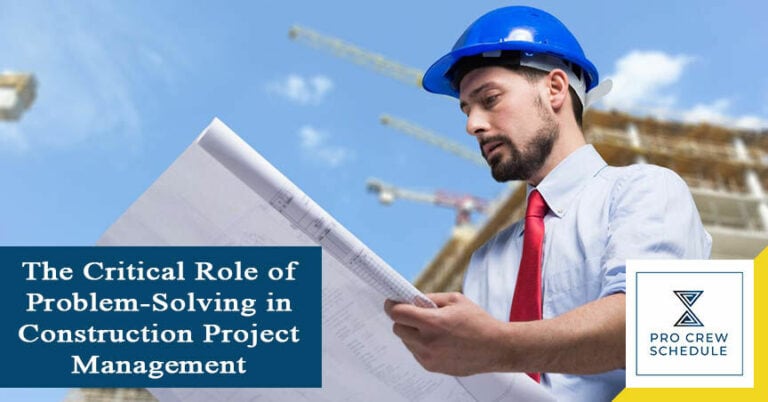Problem-solving is one of the most important skills for a good project manager. The construction industry is no stranger to problems and delays. It involves a million moving parts to finish a project, so there are a lot of risks and potential roadblocks that may hinder the project’s completion. In an article from Emerald Insights (Causes of delays in construction industry and comparative delay analysis techniques with SCL protocol | Emerald Insight), a delay means that the owner will lose money and the contractor will have higher overhead costs. While these may seem inevitable, what makes a difference is knowledge and how well you use that knowledge to solve a problem that is happening now or will happen soon.
In project management, figuring out how to solve problems is a strategic process, and it needs to be learned step by step, using a framework and considering some important things. In this short guide, we’ll show you the step-by-step process of how to solve problems efficiently and effectively. But first, let us look at the critical role of problem-solving when managing projects in construction.
The Importance of Problem-Solving in Construction
By its very nature, project management – especially construction, is a very complicated thing to do. You are leading an organization, or a company to reach its goals for the project or to work with other team members to determine the steps and approaches your project needs. No matter your job as a project manager, you will probably have to solve many problems. This will be done on both a small and a large scale, from day-to-day problems to bigger issues that could threaten the whole project.
As a result, you must know how to solve problems in project management while keeping costs and delays at a minimum. So, why do we need to focus on honing our problem-solving skills?
For Project Managers
How project managers approach problems, their strategies and procedures, and their methods will directly affect the project’s and the team’s success. You will need to look at the best ways for teams and leaders to solve problems when putting together and working on a project. For example, you need more stock levels due to late deliveries or inadequate forecasting of inventory requirements. You can create an effective construction inventory management system to help you stay on top of things – this way, you will always have the right amount of resources whenever you need them.
For Individuals or Crew members
During a project, when problems, concerns, or conflicts arise, it can be very stressful and hard for team members to deal with them effectively and on time. They might need more confidence to decide or strategize on how to go about the project. It can be scary when an employee does not know the answer. Problems need answers, but knowing how, when, and where to start looking for them can take a lot of work. Problem-solving skills are important soft skills that must be honed for each individual.
Six Steps To Solving Problems When Managing Construction
As a project manager or a general contractor, you want everything to go as smoothly and seamlessly as possible. But with the risks and potential roadblocks that can occur when managing construction, keeping your project moving with a hitch is challenging. As a result, problem-solving is a skill you can learn and improve over time.
In this section, here are six steps that you can take to improve and boost your ability to solve problems.
Find Out What The Problem Is All About
The first critical step to solving a problem is defining it and figuring out what is causing it. Getting to the bottom of what’s going wrong will help you see what needs to change. How you try to solve a problem will depend on how you describe it.
For example, you constantly need more workers for a specific period or deal with overworked crew members – which is dangerous. You could use construction crew scheduling software. This software will give you a quick overview of how many workers are assigned for a specific task or how many tasks are assigned per worker. You can assign efficient schedules for your crew with just a few simple clicks.
Find Out What Is At Stake
If the problem is small enough, you can solve it independently. Find out who is involved and put their suggestions in order of importance. When you know the problem, you can discover what is causing it. This level of analysis is important to make sure that your solutions deal with real problems, not just their symptoms.
Write Down All Possible Ideas and Solutions
Once you have done the hard work of defining the problem and figuring out what caused it, it is time to get creative and think of ways to fix it. Think of every possible outcome and its solution, then write them down. Brainstorming and mind mapping are great ways to solve problems and develop ideas.
Evaluate The Proposed Solutions and Choose the Best One
By evaluating all of the solutions, you can find the ones that solve the problem. Giving each solution a score from 0 to 10 for how well it worked helps. You can do this by figuring out the most important parts of the problem that you can use to compare each solution. Choose the solution with the highest rating from the list you made.
Take Action
Once you have decided on a solution, it is time to implement it. The solution requires more than one step or the help of others. In this case, making an action plan and considering it a mini-project would be smart.
Prepare Contingencies
Changes in how you think your solution will work out could make your plan fall apart. Make a plan B by looking at your list to find other ways to avoid this. You can do this by using your next best option to make a plan.
How Can You Improve Your and Your Team’s Problem-Solving Skills?
Managers are part of the process – you need to lead their teams and help them learn how to solve problems. This is why asking other people involved in the process or who will be affected by the final result what they think is important. You can get valuable insights from the people you work with, whether your stakeholders, subcontractors, or trade partners. In this section, read for tips on improving and developing your and your team’s problem-solving skills.
Start With A Solid Base
Companies can avoid and solve problems in the early stages of setting up new projects if they have the right foundations. Start from a strong position and let everyone take accountability for their tasks and responsibilities.
You can utilize an efficient construction workforce management system to seamlessly manage your crew members without micromanaging them. This way, everyone can see where their work fits in, who is in charge of specific tasks, and how it affects other parts of the project in real-time.
Collaborate and Communicate
Good communication and close collaboration are important at all project management stages. When giving or taking away roles and responsibilities and setting new expectations and goals, communication needs to be clear and to the point. Throughout the process, people must be able to talk to each other.
A construction task management system can help you access real-time information with simple clicks. Every team member is on the same page, reducing the risk of communication and mismanagement. This also lets you see which activities are progressing well or if your workers need assistance to finish the task.
Use Your Mind and Be Creative
No two problems have the same solution – as a result, you will need to think of solutions that will solve that specific cause. There are many creative and not-so-creative ways to solve problems. Depending on the problem, the size of your team, how your company works, and many other factors, some ways to solve problems will work better than others. Make sure you know which ones work best, and remember that you can use them alone or together.
Answer Questions and Give Feedback
Some people need help to figure out how to solve problems well. As mentioned earlier, your team might still need more confidence to make decisions and solve problems independently, especially when there are significant consequences. It takes work and helps team members learn how to solve problems to have someone to bounce questions and ideas from.
Give Your Workers More Freedom
When people with a lot of power have to solve bigger problems, they should include their employees. They should ask workers for feedback, especially if the issue involves changing an internal process. At the task level, employees must be able to help make decisions. Still, managers need to show them that they value how they solve problems, especially regarding more strategic questions.
Managers should give them more power and tasks if they can. When team members feel like they have power, they work harder. Higher-ups should give them tasks that will stretch them and help them grow, and they should also give them the training to help them grow.







